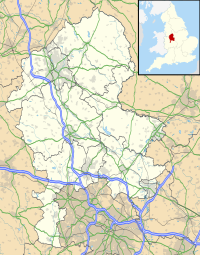St Mary's Church, Patshull
| St Mary's Church, Patshull | |
|---|---|

St Mary's Church, Patshull, from the south
|
|
| Coordinates: 52°36′12″N 2°17′45″W / 52.6034°N 2.2958°W | |
| OS grid reference | SJ 800 006 |
| Location | Near Pattingham, Staffordshire |
| Country | England |
| Denomination | Anglican |
| Website | Churches Conservation Trust |
| Architecture | |
| Functional status | Redundant |
| Heritage designation | Grade II* |
| Designated | 27 June 1963 |
| Architect(s) | James Gibbs, W. C. Banks |
| Architectural type | Church |
| Style | Georgian |
| Completed | 1874 |
| Specifications | |
| Materials | Sandstone, lead roofs |
St Mary's Church, Patshull, is a redundant Anglican church near the village of Pattingham, Staffordshire, England, and is situated near Patshull Hall. It is recorded in the National Heritage List for England as a designated Grade II* listed building, and is under the care of the Churches Conservation Trust. The church stands in parkland beside a lake.
St Mary's was built in about 1743, and was designed by James Gibbs for Sir John Astley. It replaced an earlier medieval church on the site. Additions were made to it in 1874 by W. C. Banks. These included a north aisle, a bell tower, and a dome.
The church is constructed in sandstone, with lead roofs. Its plan consists of a three-bay nave with a north aisle, a single-bay chancel with a north vestry, and a west tower. At the corners of the church and the tower are rusticated quoins. The tower is in three stages, the lower and middle stages being separated by a string course, and between the middle and top stages is a cornice. It contains round-headed and circular windows, and in the top stage are round-headed louvred bell openings flanked by Tuscan pilasters. It is surmounted by a lead cupola. At the east end of the church is a Venetian window, above which is a pedimented gable. Along the sides of the church are round-headed windows and, in the nave between these, are circular windows. In the middle of the south side is a porch supported by Tuscan pillars.
...
Wikipedia

